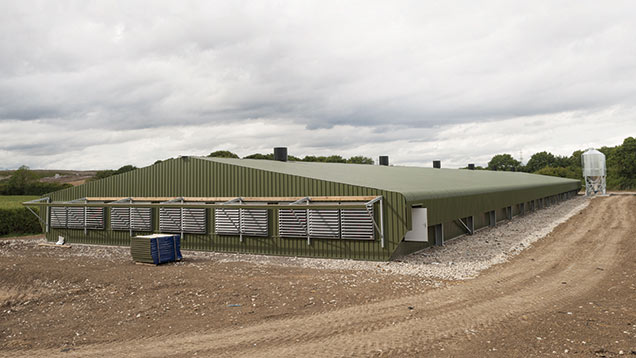Poultry shed count reveals aged housing despite new builds
 ©Jim Varney
©Jim Varney Improved profitability in the poultry supply chain has encouraged a spate of shed building in the past five years, though the sector overall is still characterised by an aged infrastructure.
According to the most recent Housing Age Survey, prepared by the NFU in collaboration with the British Poultry Council, over half of all broiler sheds in the country (54%) are still more than 25 years old, while 25% are more than 40.
The average age of poultry house in the UK (by number of houses) now stands at 32 years.
This compares with 27 years old when the survey was last conducted five years ago – suggesting no improvement at all.
See also: 2009 shed survey in summary
“Despite the recent new builds, the average age of UK poultry housing continues to increase,” says the NFU in its report.
“This jeopardises the ability of a sector that is vital to UK food security to improve productivity.”
But it’s not all bad news and, when expressed in terms of housing area rather than number of houses, the average age of a shed now stands at 27, compared with 24 five years ago.
“This reflects the fact that newer houses are typically larger than older ones,” the NFU explains.
This is evidenced in the chart below, which shows how the 250 new sheds constructed in the past four years cover an area of about 490,000 sq m. In 1966-70, it took 600 sheds to cover the same area.
Building spikes
The survey also reveals that there have been three clear “spikes” in terms of poultry shed building – the mid- to late-1960s, the mid- to late-1980s, and 2010 onwards.
“The first spike represents a time when poultry farming grew rapidly in response to burgeoning consumer demand, backed up by the introduction of more intensive farming techniques,” explains the NFU in its report.
About the NFU shed survey
Broiler producers were asked three basic questions as part of the Housing Age Survey – how many sheds they use to grow chicken, the size of these sheds and their build date or age.
In total, the NFU collected data relating to some 3,210 individual houses, with a combined area of 4.1m sq m.
This was almost double the response achieved in 2009, the last time the survey was undertaken, and equates to an estimated 785,000t of annual production, or 65% of the industry’s output.
Such a response rate has been described as “brilliant” by NFU poultry board member Kinsey Hern, who co-ordinated the study.
“The whole of the broiler industry has pulled together and has given significant strength to the information to prepare for the future.”
According to NFU head of tax, Michael Parker, the report provides useful evidence both of where poultry farmers have been able to expand, and some of the key barriers which still exist.
“I believe it will be invaluable in providing the sort of evidence we need to support our lobbying work for tax policies which actively encourage business investment.”
Government grants also played a role in this era, as agriculture was encouraged to modernise.
The second spike in the mid-1980s reflects the strong market conditions that pertained at the time, when farmers and poultry companies had the available profit to reinvest in new housing.
And the third, most recent spike again represents an era of better profitability, as well as an element of catching up, following the period of poor investment before 2009.
According to the NFU, the market post-2009 benefited from a reduction in the value of sterling against the euro, (which boosts competitiveness and makes imports more expensive), combined with a surge in demand for lower cost protein in the immediate post-recession period.
It also points to Tesco’s commitment to source 100% fresh British chicken in the wake of the horsemeat scandal in 2013 as another factor fuelling the market.
This target was reached fairly swiftly following the promise made by former chief executive, Philip Clarke, at the NFU’s 2013 annual conference – necessitating a significant production expansion by integrators supplying those contracts.
More modern stock
As a result, a greater proportion of the current poultry housing stock can now claim to have been built this century.
According to the 2009 survey, just 8% of existing sheds had been built since 2000. But the latest report shows that this now stands at 24%, with 17% put up in the last 10 years alone.
“The industry has been able to reinvest at farm level, building more space in the past five years than the previous 10 combined,” says NFU chief poultry adviser Gary Ford.
“It has also grown at a faster rate than any other time since 1996.”
Moreover, this spate of new shed building has been carried out across the whole spectrum of businesses, including integrated companies, specialist broiler growers and mixed farms diversifying into poultry.
“Our results tell us that every type of farmer has responded to the investment challenge on the back of consistent, stronger farm gate pricing, that has enabled returns to improve to a more viable place,” says NFU poultry board chairman Duncan Priestner.
“It clearly shows that returns above survival need to be there to enable constant reinvestment, meeting the future challenges of the environment, disease and, most importantly, the supply of safe and valued food onto the British public’s plate.
“Furthermore, producers need a supporting and sympathetic government, whose environmental, planning and tax policy doesn’t hinder future development of our industry. This will be critical to UK food security.”
This view is echoed by British Poultry Council chairman, John Reed. “It is particularly pleasing to see how farmers have responded positively to the growth of the UK chicken market in collaboration with the industry`s processors,” he says.
“It supports the call for adequate returns across the supply chain to give farmers the confidence in making the necessary investments in new and existing housing.”

